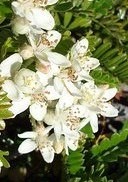Hawaiian hawthorn
(Osteomeles anthyllidifolia)

Description
Osteomeles anthyllidifolia, commonly called Hawaiian rose, or Hawaiian hawthorn, is a species of flowering shrub in the rose family, Rosaceae, that is indigenous to Hawaiʻi, the Cook Islands, Tonga, Pitcairn Island, and Rapa Iti,Taiwan and the Ryukyu islands of Japan Osteomeles anthyllidifolia grows as either an erect shrub that reaches 3 metres (9.8 ft) or a spreading shrub. The compound leaves are alternately arranged on branches and divided into 15–25 leaflets. The small, oblong leaflets are 1.5 centimetres (0.59 in) long and 0.7 centimetres (0.28 in) wide. White flowers with five 7–11-millimetre (0.28–0.43 in) petals form clusters of three to six on the ends of branches. The fruit is white when ripe, 1.0 centimetre (0.39 in) in diameter, and contains yellow seeds that are 1.5 millimetres (0.059 in) in diameter. Osteomeles anthyllidifolia can be found in dry to mesic forests, shrublands, coastal areas, and lava plains at elevations of 2–2,320 metres (6.6–7,611.5 ft). It is a ruderal species, able to effectively compete with other plants on disturbed sites Osteomeles is a genus of flowering plants in the rose family, Rosaceae. They are shrubs native to eastern Asia, with compound leaves, opposite leaf arrangement, and small pome fruit. The fruits of all species in this genus are edible The genus has sometimes been considered to include South American species of Hesperomeles which, like Osteomeles, have only one ovule per locule and hard pyrenes. But Hesperomeles notably have simple leaves, and recent molecular phylogenetics suggest that the two genera are only distantly related
Taxonomic tree:







